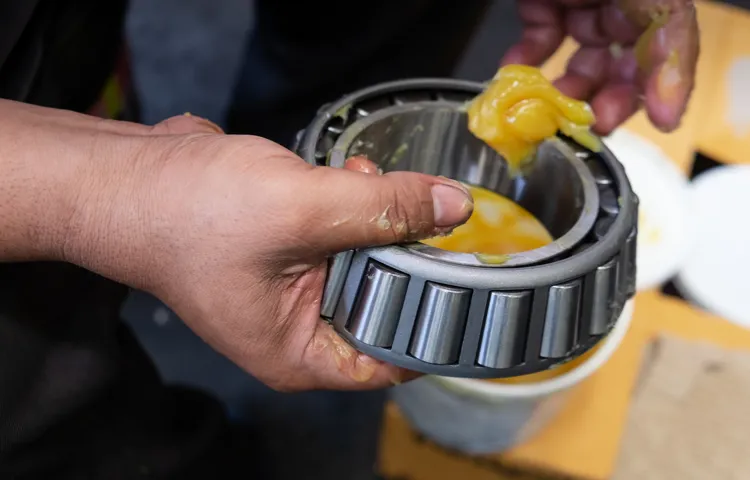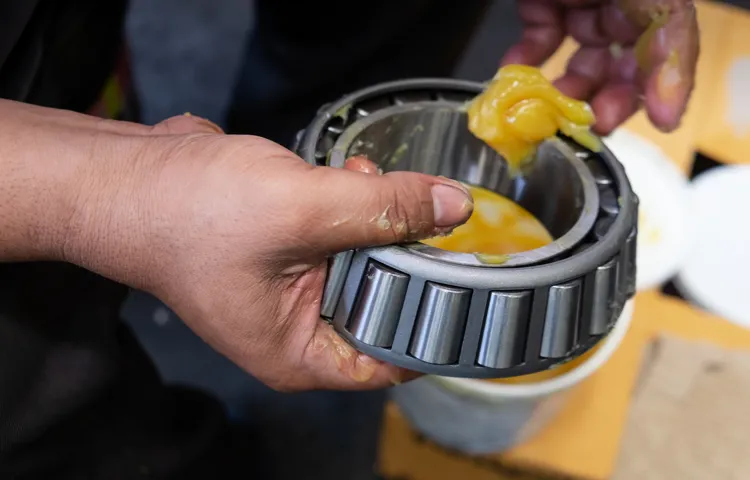Bearing grease is a crucial part of machinery functioning, yet most people don’t fully understand what it is and how it works. If you’re someone who has ever wondered about the mechanics behind bearing grease, or the purpose it serves, then you’ve come to the right place! In this blog, we will delve into the intricacies of bearing grease and provide you with a comprehensive understanding of everything you need to know. From the chemical composition of grease to how it is used in different machinery, this blog has it all.
So let’s dive in and explore the world of bearing grease!
Table of Contents
What is Bearing Grease?
If you’re a fan of machinery, whether working with your car or maintaining heavy industrial equipment, you’ve probably heard the term “bearing grease” many times. But what is bearing grease exactly? Well, in simple terms, bearing grease is a lubricant that is used to minimize friction between moving metal parts of a machine. It is comprised of a base oil and a thickener, with additional performance additives specifically designed to enhance its effectiveness under various conditions.
The thickener itself is made of either soap or polyurea and is responsible for holding the oil and additives together to create a viscous, semi-solid consistency. With its ability to maintain its performance under extreme conditions of temperature and pressure, bearing grease is an essential tool for keeping machines and equipment running smoothly and efficiently.
Composition of Bearing Grease
Bearing grease is a crucial component in maintaining the optimal function and lifespan of bearings. This type of grease is specifically designed to reduce friction and wear between the moving parts of a bearing. The composition of bearing grease typically consists of a base oil and a thickening agent.
The base oil can be mineral-based or synthetic, depending on the specific application and conditions that the grease will be used in. The thickening agent is added to the base oil to give the grease its viscous, gel-like consistency. Common thickening agents include lithium-based, calcium-based, and polyurea-based mixes.
Additionally, additives such as anti-wear agents, rust inhibitors, and extreme pressure agents can also be added to enhance the performance of the grease. With the right mixture of base oil, thickening agent, and additives, bearing grease can effectively reduce friction, prevent wear, and prolong the life of bearings.

Properties of Bearing Grease
Bearing grease is a lubricating substance used for bearings and other machine parts that rub against each other. It is made of a mixture of base oil, thickener, and various types of additives that determine its properties. The base oil can be either mineral or synthetic, and its viscosity is crucial to the grease’s ability to flow and remain in place.
The thickener, which is usually a metallic soap, helps hold the base oil in place and enhances its load-carrying capacity. Additives such as antioxidants, anti-wear agents, and extreme pressure agents are added to improve the grease’s performance under different conditions. The right choice of grease depends on the operating conditions, such as temperature, load, speed, and environment.
A high-quality bearing grease can help increase the lifespan of bearings and reduce maintenance costs.
Why is Bearing Grease Important?
Bearing grease is a lubricant specifically designed for use in ball bearings and other types of machinery. It’s an essential component that helps reduce friction and wear, while also preventing rust and corrosion. Without bearing grease, the bearings in your machines would wear out quickly, resulting in costly repairs, downtime, and reduced efficiency.
When choosing a bearing grease, it’s important to consider factors such as temperature range, load capacity, and compatibility with different types of materials. With the right bearing grease, you can ensure that your machines run smoothly and reliably, resulting in improved performance and longevity. So next time you’re working on your machinery, make sure to pay attention to the importance of bearing grease.
Benefits of Bearing Grease
Bearing grease is an essential component when it comes to maintaining the life and reliability of bearings in machinery. It’s a lubricant that is thicker and stickier than oil, and it’s used to prevent metal-to-metal contact between the rotating bearing components. By applying bearing grease, the friction between these components is reduced, which results in less heat buildup and wear.
One of the benefits of using bearing grease is that it’s more durable than oil. With oil, the fluid tends to leak faster from the bearing, leaving it dry and causing more friction. Bearing grease stays in place and doesn’t drip, making it an excellent choice for machinery that operates at high speeds and in harsh environments.
Furthermore, the application of bearing grease helps to reduce maintenance costs by extending the life of the bearings, minimizing the need for frequent replacements. Hence, bearing grease is crucial for ensuring that machinery operates smoothly, safely, and efficiently.
Applications of Bearing Grease
Bearing grease is essential to maintain the performance and lifespan of bearings. It functions as a lubricant that reduces friction and wear between the moving parts of machinery, preventing premature failure. Its viscous nature also helps to seal out contaminants and moisture, which can cause further harm to the bearings.
By applying an appropriate amount of grease, you can prolong the operational life of your bearings and reduce maintenance costs in the long run. Without it, bearings can become noisy, overheat, and eventually seize up, leading to costly downtime and repairs. In essence, bearing grease acts as a protective shield that preserves the integrity of your machinery and ensures optimal performance.
Factors to Consider when Choosing Bearing Grease
Bearing grease is a crucial element when it comes to maintaining your equipment’s functionality. It works by creating a layer between two metal surfaces which prevents wear and tear due to friction. However, it is critical that you consider several factors when choosing bearing grease.
One of the crucial factors you need to consider is the viscosity of the grease. The viscosity should be such that it can effectively and evenly distribute itself throughout the bearing. Additionally, you need to consider the operating temperature of the equipment.
The bearing grease you choose should work well within the specific temperature range to reduce the likelihood of lubrication failure. Other elemental factors that need consideration include the load capacity, speed, and water resistance of the grease. Furthermore, select a type of grease that can easily be applied to the equipment and will not create any contamination risk.
In summary, choosing the right bearing grease can help prolong the equipment’s life and prevent downtime due to premature failure.
How to Use Bearing Grease?
Bearing grease is a lubricating substance specifically designed for bearings. It is meant to reduce friction and prevent wear and tear on the bearings, helping them last longer and perform better. Using bearing grease is a relatively simple process.
First, ensure that the bearing is clean and free of debris. Then, use a greasing tool or your fingers to apply a small amount of grease evenly around the bearing. Be careful not to over-grease, as this can cause the bearing to overheat and fail.
The frequency of greasing the bearing depends on its usage and operating conditions, but a general rule of thumb is to grease it every six months or every 10,000 miles, whichever comes first. It is essential to use the appropriate type of bearing grease for the specific application. Choosing the wrong type of grease can cause damage, corrosion, or failure to the bearing.
Therefore, always consult with the manufacturer’s recommendations to select the right bearing grease. With proper application and maintenance, bearing grease can help extend the lifespan of your bearings and keep them running smoothly for longer.
Steps for Applying Bearing Grease
Bearing Grease Applying bearing grease is an essential aspect of maintaining and extending the lifespan of bearings. To start the process, ensure that the surface of the bearing is clean by removing any debris or dust buildup. The next step is to apply the grease by squeezing it generously onto the bearings, ensuring that each rotation point is covered.
Avoid over-greasing, as this can lead to lubrication blockage or leakage, damaging the bearing’s performance. Once the bearing is coated in grease, rotate it to distribute the grease evenly across all the contact areas. It’s also necessary to ensure that the bearing housing is clean before replacing the bearing.
Finally, ensure that you check and apply the recommended amount of grease at standard maintenance intervals. By following these steps, you can ensure the optimal performance and longevity of your bearings, ultimately saving time and money.
Precautions when using Bearing Grease
If you’re using bearing grease, it’s essential to take some precautions to ensure effective operation. Firstly, it’s important to choose the right type of bearing grease for your specific needs. There are many different types of bearing grease available, each designed for a specific purpose.
It’s crucial to use the right grease for your application, as using the wrong grease can result in damage to your bearings and the equipment they’re used in. Before applying the grease, make sure the bearings are clean and free from debris. Any contamination can cause improper operation and premature failure.
It’s best to use a designated cleaning solution instead of water or solvents, as these can lead to corrosion and other complications. When applying grease, make sure to use the recommended amount. Over-greasing can lead to increased friction and heat, which can cause damage to your bearings over time.
Applying too little grease can lead to inadequate lubrication, resulting in premature wear. After application, make sure to properly store and handle your bearing grease to avoid contamination. Keep it in a sealed container and avoid exposing it to air or moisture.
In summary, using bearing grease can be a highly effective way to ensure proper bearing lubrication. However, it’s crucial to take the proper precautions to ensure safe and effective operation. Remember to choose the right type of grease for your application, thoroughly clean your bearings before applying grease, use the recommended amount, and properly store and handle your grease to avoid contamination.
By following these guidelines, you can ensure maximum bearing performance and longevity.
Conclusion
In short, bearing grease is the deliciously sticky and elusive substance that keeps our mechanical contraptions running smoothly. It’s the glue that binds the metal components of our world together, preventing friction from tearing them apart. So whether you’re fixing a bike, revving up your car, or oiling the cogs of an industrial machine, remember the importance of this humble but vital substance – and make sure you have plenty of it in stock!”
FAQs
What is bearing grease used for?
Bearing grease is used to lubricate bearings, which reduces friction and prevents wear and tear.
What are the different types of bearing grease?
There are several types of bearing grease, including lithium, synthetic, polyurea, and calcium sulfonate complex.
How often should bearing grease be changed?
The frequency of bearing grease changes depends on the application, but generally, it should be changed every 6-12 months or after 10,000-15,000 miles.
What are the benefits of using bearing grease?
Using bearing grease can help extend the life of bearings, improve their performance, and reduce maintenance and repair costs.
Can bearing grease be used in extreme temperatures?
Yes, some types of bearing grease are designed to withstand extreme temperatures, such as high-heat environments or freezing temperatures.
What are the factors to consider when selecting a bearing grease?
Factors to consider include the application, operating temperature, load capacity, and compatibility with the bearing material.
How is bearing grease applied?
Bearing grease can be applied using a grease gun or other lubrication tools, and it should be evenly distributed around the bearing surface.


